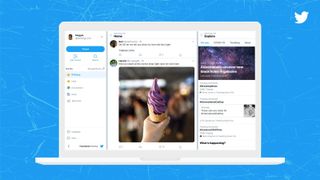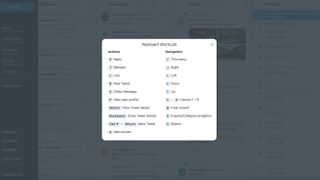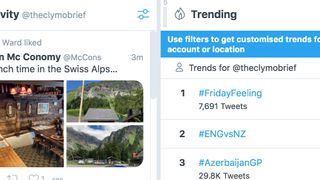TechRadar Verdict
TweetDeck isn’t so much a one-stop solution for social media management tasks as a dedicated tool for getting the best from Twitter. Some might feel that limits its appeal, but if your business makes use of tweets to get its messaging across, and generate customer interaction as a result, it may prove highly useful. There’s a busy but potent interface, which has been poked and provided over the years to produce a current edition that’s relatively easy to use. It might not do it all, but TweetDeck is a tweeter’s must-have.
Pros
- +
Easily customised
- +
Some decent power tools
- +
Supports multiple accounts
Cons
- -
Busy interface
- -
Limited to Twitter use
Why you can trust TechRadar
TweetDeck is a browser-based package that can is ideally suited to help business users with their tweet-focused social media management workload. As the name suggests, the core focus is based around Twitter, and it can be well suited to anyone that uses the social media chat platform for both business and pleasure.
However, it is also possible to keep TweetDeck purely for business and thanks to the array of tools inside the interface, managing an account is very straightforward if your looking for one of the best social media management tools.
The great thing about TweetDeck for many is that it can be used within a web browser, and allows you to manage multiple items at once. This is a great way to streamline activities, especially if you’re spinning a lot of plates at the same time.
TweetDeck might not be quite so well suited for business users who want to work with other social media platforms, but as part of a co-ordinated strategy it can be a powerful tool.
Plans and Pricing
Much of the appeal with TweetDeck is that you can make use of it for free, without entering into any complicated plans or pricing options. In fact, you can get started with TweetDeck using an existing Twitter account, enlisting the same log-in details to get up and running.

Further expanding that appeal is the ability to add any other Twitter accounts if you have them, or as they are created. This gives it extensive appeal if you’re a Twitter aficionado, though it does also make the app become rather busy than it already is. That’s especially so if you’ve got lots of columns activated.
Core features
Tweet Deck is, in essence, a social media dashboard application, which lets anyone manage their tweets and associated interaction within the convenience of a web browser. Being that TweetDeck is now owned by Twitter means that all of the features and functions are designed to offer a seamless experience for users, which is by and large exactly what to you get once you’ve signed up. It does, of course, also work brilliantly within the realms of an iPhone or Android app, meaning that it can be a powerful tool when you’re on the go.
In terms of features, these have been shaped nicely over the last few years so that it is now possible to do a lot more than in previous incarnations of TweetDeck. For example, Twitter now lets you filter messages much more effectively no matter how many followers you have. The fact that there’s a one-stop dashboard also makes management of tasks much more streamlined.
In other words, this means you can handle tweets, messages and notifications with ease, as well as keeping tabs on trending hashtags. The latter is really useful if you’re following the progress of a particular campaign, although can prove quite challenging if you have several things going on at once. Thankfully, TweetDeck can now be tweaked and fine-tuned within the interface so that you can better manage activities without getting too tied up in knots.

Newer features
Lookout too, for the new ‘Trending’ option, which allows you to add another column that delivers all of the latest developments, dynamically and as they happen. It's a great addition, particularly if you have your own content that makes it to the list. In the same way as the other columns, you can drag and drop this in amongst the others as and when you need it.
The other natty feature worth mentioned is the keyboard shortcuts option. If you’re prolific on Twitter this can be a real boon, allowing you to speed up your workflow. It’s additionally handy for getting the search option up quickly, if you’re on the lookout for something in particular. Full marks to Twitter for making everything that little bit slicker with the latest incarnation.
Column options
TweetDeck is primarily about columns, which sit on the viewable area on your screen and deliver a variety of information, depending how you have them configured. At the left of your screen there are core controls, which let you tweak and fine-tune the interface as needed. You can stick with default options or dip into the controls and choose to configure the interface with more columns as needed.
The options include Home, User, Notifications and Search. These are followed by List, Collection, Trending, Likes, Messages, Mentions, Followers, Scheduled, Messages (all accounts), Mentions (all accounts) and Activity. If you enlist them all there is the tendency for the interface to become a little over the top, but it is doable although works to best effect if you have a large or dual monitor setup.

Interface and in Use
If you like to be organised with your social media marketing activities then TweetDeck can be an impressive tool to have at your disposal. The interface lets you see what’s happening with your accounts via a set of columns that sit across your browser or app display. These can be customised to suit different needs with the ability to mix and match content without too much in the way of manual intervention.
The other big benefit with TweetDeck is that it makes the management of multiple accounts that much easier. However, first time users may find that it all looks a little bit chaotic, but once you’ve got to grips with the interface, the column setup and how to set it up to best effect, the overall appeal is pretty universal. Twitter has also been working on tweaks over the last year or so that have made the interface even more user friendly, which is welcome news.

Support
Due to the fact that TweetDeck is more like an extension of the regular Twitter experience you’ll find less of a support structure than that delivered by other dedicated social media management tools. That’s not to its detriment, however, as the browser-based software is generally pretty easy to use and also seems pretty stable no matter what platform you’re using it on.
The only issue you may encounter is having the capacity to keep up with all of the columns and the information flooding through them, depending on how many you have active at any given time. Minor queries or questions can also be answered by searching online or asking other users, so the minimal support options are nothing to worry about.
The Competition
TweetDeck will certainly appeal to individuals and business users who spend much of their time and focus on Twitter. However, for a wider range of options it's a good idea to check out the likes of Hootsuite, SocialPilot, Buffer, eClincher, Sendible, Statusbrew, Loomly and Zoho Social. All are perfectly decent competitors worthy of investigation.
Final Verdict
TweetDeck is of definite appeal if you’re a business owner who’s content to try and exploit the value of tweeting about your activities. While there’s no cost involved it doesn’t always have quite the same muscle as some of the other more inclusive social media management tools that are out there.
Nevertheless, given that it is a free application there’s no harm or risk in giving it a try. You may find that it’s useful to sit alongside other more comprehensive social media management solutions. Alternatively, if you only have an interest in pushing your business via Twitter then it may well contain everything you need.
- You can signup to TweetDeck here.
Rob Clymo has been a tech journalist for more years than he can actually remember, having started out in the wacky world of print magazines before discovering the power of the internet. Since he's been all-digital he has run the Innovation channel during a few years at Microsoft as well as turning out regular news, reviews, features and other content for the likes of TechRadar, TechRadar Pro, Tom's Guide, Fit&Well, Gizmodo, Shortlist, Automotive Interiors World, Automotive Testing Technology International, Future of Transportation and Electric & Hybrid Vehicle Technology International. In the rare moments he's not working he's usually out and about on one of numerous e-bikes in his collection.


